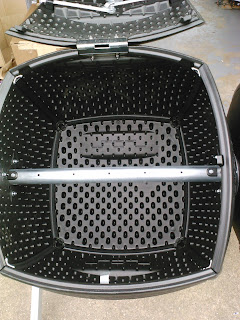I compost. A lot. It is really what I do when I wake up every day. I put on some PJ bottoms, loafers, and go out to check and turn the compost bins. It's like walking to the store to get coffee, or opening all the blinds in the house, or walking the dog. It's that little bit of relaxing exercise that prevents one from needing a 3rd cup of caffeine in the day.
I use a tumbler composter because it's fast (and it was cheap at Costco - an adult toy that I absolutely had to have). Rapid composting from what I can tell was invented by Robert D. Raabe, Professor of Plant Pathology, at UC Berkeley and summarized here (also on referencs page). It basically says, if you can control the temperature, oxygen, and carbon to nitrogen (C:N) ratio, and scrap size, and turn your compost pile a lot, you can reduce the time to prepare it from 1 year (52 weeks) to 3 weeks. Im a big fan of tools, because tools do two things: 1) turn apes into people and 2) make work suck less. Dont get me wrong, I own a pitchfork, but I also own a composter, so that I can turn a barrel on its axis 10 times in the morning before coffee instead of lifting 200 lbs of compost all afternoon. If you want to rapid compost, you need a bin. I am happily biased towards tumbler designs.
So after reading a bunch about composting, I decided my habits of continuous processing and overstuffing the bin had to end. I needed more space for composting batches in progress. I saw two solutions to this problem. The cheapskate-cheaps-out solution would be to get another garbage bin (with a lid) which would act as a pre-composting bin. Scraps and any other household garbage that is compostable would go in there to wait until the composter was ready for another batch, and then the garbage bin would be dumped into the composter to begin another batch. I told my wife, who had just last week, found some rat holes on the property, and told me that was a stupid idea. I tried to politely defend the idea, but got one of those you-can-listen-to-me-now-or-pay-for-it-later looks. So we went with the second solution: we bought a second composter.
Except that the one at Costco, is not one composter like the one I had bought two years earlier, but two smaller ones stuck together for almost twice the price. I deliberated. I capitulated. I bought the damn thing. Another Lifetime product, this time a 60072 DUAL COMPOST TUMBLER.
Cons: It is a lifetime product and comes with language independent instructions (think Lego and Ikea) except that the required tools involve inter alia: a power drill, mallet, needlenose pliers and eye saftey. Forget "some assembely required" the instructions explicitly say (in language independent form) that you need two people, and aren't allowed to use children. See for yourself:
(From page 6 of the manual)
Pros: It is a lifetime product and comes with language independent instructions. Like my other Lifetime tumbler, it is indestructible at any phase of construction. Almost all the features of the single tumbler I had come to find annoying over 2 years have been fixed in this iteration. The seams are not bound with metal plates which rust. The tumbler walls are more resistant to infiltration by water. The tumblers are smaller, which make it easier to roll when it's weighed down. The legs are sturdier. The middle axis goes all the way through and is made of metal, not the POS PVC bar that bowed and deformed under the heat of the composter in two days.
The inside. The bin spins around the perforated metal bar in the middle, which adds air to the core of the pile, increasing the speed of the composting reactions. Not the double locking mechanism at the top of the above photo, and the twisting handle on the bottom photo.
The legs are made from hollow rectagular steel beams, not the bent galvanized steel conduit of the last one. To lock the bin in place, pull up on the green handle near the axis. A pin slides into place so that you can open the bin without torquing plant shit onto your shoes or forcefully into your nose.
Here is my first experiment in the new bin. Weeds, used bunny hay, kitchen scraps, shredded paper and large undigested pieces from the last compost batch, and a bunch of water. Like the other model, the bottom will leak to an extent, so fell free to soak your pile to start with, the excess will leak out.
My laboratory. The old big composer is on the left, and the new one with the two bins is on the right. These were taken two days ago. The compost batch was already steaming 2 hours later, and today (2 days later) has already reduced in volume, has white fungus patches and is browner. Batch processing is totally the way to go. Next step is to check the temperature inside, and see if it is hot enough to kill weed seeds.





